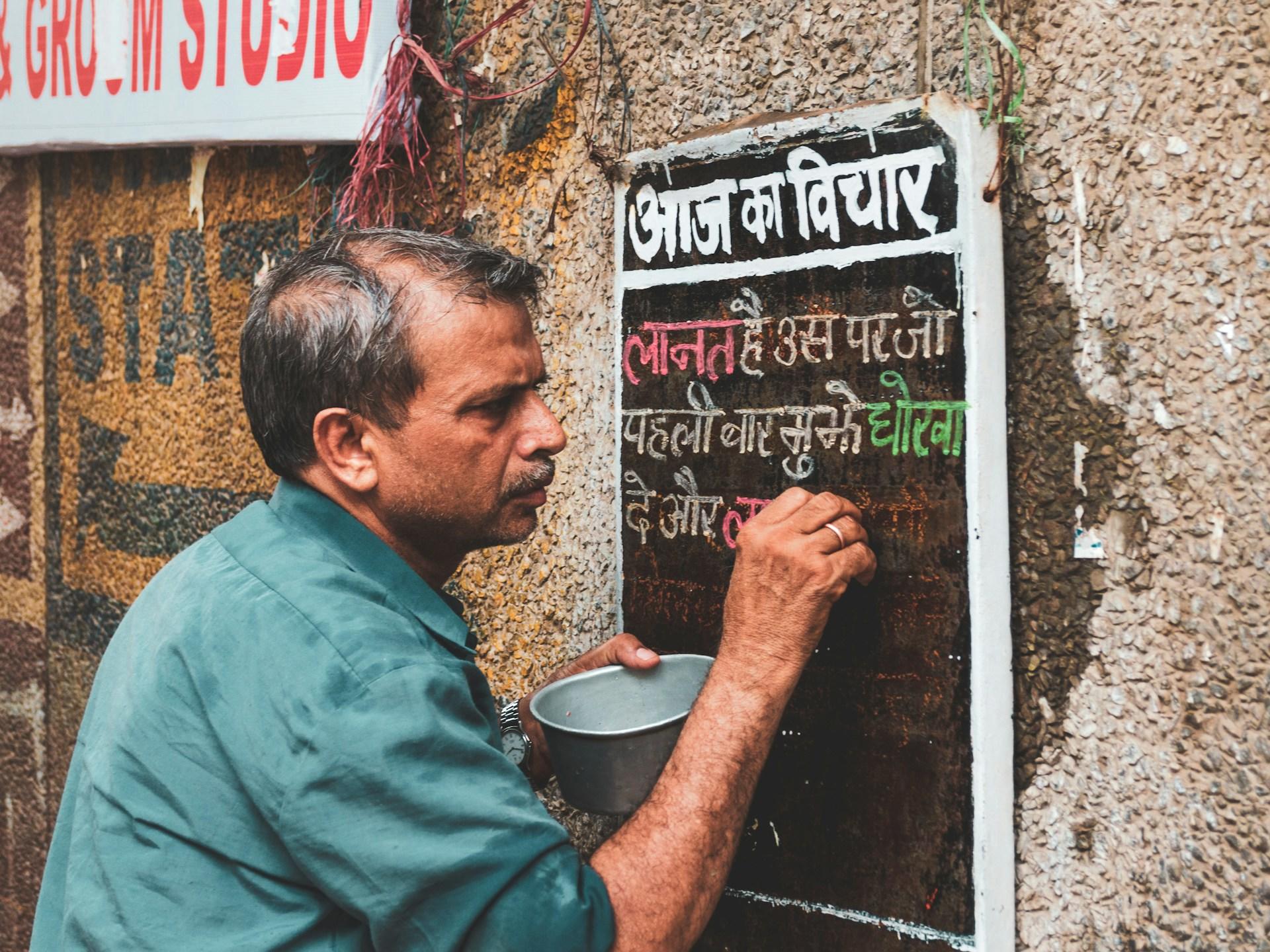Hindi is the official language of India and is spoken in regions all over the country. with over 250 million speakers in northern India alone. Between native speakers and students, there are around 425 million speakers in total, making it the 4th most spoken language in the world.
This proliferation means that more and more people across the world are starting to see the value in taking courses to improve their Hindi skills in areas like reading, speaking, writing and listening.
But before we get into the pros and cons of all the different ways learners can study Hindi, let's take a little history class:
To do this, we have to look at two different areas- written and spoken Hindi. Hindi is written in a script called Devanagari, which was strongly influenced by Sanskrit and examples of the modern version of the script were first seen around the 11th century.
The modern version of the Devanagari script, which is basically the Hindi alphabet, consists of 14 vowels and 33 consonants. You may be surprised to know it's not only used as a script for Hindi but is used for a range of languages like Marathi, Nepali and more.
In fact, Devanagari is the fourth most widely adopted writing system in the world!
Onto spoken Hindi...given the sheer size of India, it's not surprising to know that there were, and still are, many regional dialects and languages. In fact, Hindi acts as a lingua franca for many who wouldn't be able to understand each other otherwise.
The Hindi spoken today in India is the Modern Standard version, which is actually based on the dialect and accent of Delhi and its surrounding regions which was standardized over a period of decades.
So now that you have a little background about the language, it's time to consider the different ways you can learn the language and the pros and cons of each.
Let's start with one type of course that we believe to be the most effective: private lessons...

Studying Hindi With A Tutor: How To Find One and What You May Pay

Instead of learning a language word by word using an app, or paying for impersonal online programs like Rosetta Stone, if people are serious about improving their basic knowledge of Hindi, then private classes are the way to go.
Pros include the fact that you have a helpful teacher who will explain all the features of the language and give you the opportunity to practice your skills, lesson after lesson. One of the most important pros is that people can work at their own pace, not worrying about other learners.
So, how can you go about finding Hindi classes in your area? Well, there are actually a few options:
- Language Schools and Universities: These places are full of helpful and passionate teachers, who are usually available for one-on-one courses. One of the cons of this search is that they may charge more per class because of their expertise.
- Hindi Cultural Associations: Because of the large Indian diaspora in Australia, there are many of these associations, where Indian people can connect with the people in their community. A quick phone call to one of these groups may be enough to provide you with a good list of potential tutors in your local area.
- Search Online: This is probably the go-to method for most people, and usually has some very positive results. You can make a post to see if there's someone in your community of friends who can help, or use an online platform like Superprof.com.
Superprof is a helpful platform that aims to connect students to tutors for classes in a range of areas, from cooking to English literature and, of course, Hindi. Just search for a Hindi teacher in your location and you could be starting your first lesson the very next day!
So what about the cost?
Well, Hindi lessons have a range of prices, depending on factors such as:
- Teaching qualifications;
- Years of experience;
- Type of lesson (conversation, academic, business etc.);
- Duration of lesson and courses;
- Level of the students; and
- Location, including prices for online lessons.
All of these factors will affect the amount that a teacher chooses to charge for per lesson. In Australia, the average cost for a private lesson with a Superprof tutor is around $23 per hour-long class.
When making your decision, think carefully about your language priorities and what you want to work on the most. If you simply need to speak, then a lesson with a less experienced (and probably cheaper) tutor is going to be helpful enough.
However, if you need to learn Hindi for work or study, then you may need to be ready to pay a little bit more for your classes and invest in some of the best teachers and resources available.
No Rosetta Stone: Great Online Resources to Help You Study

To supplement their courses, many students buy dictionaries or grammar and vocabulary books to read, full of verbs and their conjugations. While these tools can help you at the more basic stages of your learning, there are better (and more fun) options out there.
Try helpful and interactive online tools specifically made for language learners. Here's a quick list of our favourites, some of which are free:
HindiPod101
The HindiPod101 course provides students with podcast-style audio and video content that they can stream or download for offline learning. These materials aim to teach common Hindi phrases such as greetings used in India and more.
There are plenty of features like a grammar and vocabulary database, a flashcard app and so much more. This service isn't free, but at only $8 a month for the most basic plan, it's a great option.
Drops
Drops is a good option for students who want to tackle their Hindi study a little every day. Created by teacher-favourite Kahoot, Drops is a free app that focuses mostly on vocabulary, using images for word association and games to review every word you learn.
The people at Drops recommend that you start with just five minutes a day and slowly build a language learning habit over time. One of the cons of this app is that there's very little grammar instruction.
These are only two options but there are so many resources you can use to practice like Tandem, DuoLingo, Memrise and more. Try them all and find the app that works best for your learning!
Is It Possible To Learn Hindi Without Classes?
The short answer is... yes! Anyone can learn any language on their own, as long as they have the discipline and commitment to study every single day. However, learning a new language by yourself is certainly going to be a challenge.
Here are some tips we can offer to make sure you get the best out of your Hindi practice...
1. Have Plenty of Resources to Help You
The truth is that you simply can't learn a language without helpful materials and resources to guide you along the way. These resources can be free or paid, as long as they're trustworthy and up to date.
For those who work best with physical materials, the best place to start is a workbook or tracing book to practice writing the Devanagari script. While these materials are often designed for kids, they're still very effective for adult learners as well.
You might also want to buy a textbook such as 'Hindi: A Complete Course for Beginners' by Living Language, which can guide you step by step as you plan what you're going to look at each class.
For those who prefer interactive practice, as we mentioned before, there's plenty of free practice of grammar and vocabulary available online. Apps like Drops, Duolingo and Memrise can be very effective for learning basic vocabulary and verbs.
If you're more interested in grammar or conversation, you could try programs like Rosetta Stone or Pimsleur, respectively. These programs are designed to help solo students find a structure to follow that can fit into their daily lives.
Finally, you must have access to real-world materials from books and magazines to films and music. This way, you can hear and read Hindi as it's really used, rather than the academic version we read about in books.
2. Find Someone To Practice With

While there are many pros to being a solo learner, it's hard to get past one of the major cons: no speaking practice.
We often get so lost in the need to learn and memorise vocabulary, verbs, grammar structures and more, that we forget the real point of studying languages: to communicate with other people.
Your Hindi course won't do much good if you never actually get to speak Hindi.
To be able to solve this problem, the best option is to find a partner to practice with- either a fellow student or a native speaker in your community. You might be thinking, 'Well, that's certainly easier said than done.'
The reality is that there are plenty of ways to go about finding speaking partners. One of the best is the app Tandem, which allows you to connect with language learners around the world. You can teach English to someone while you improve your Hindi skills.
Otherwise, you can contact your local Hindi or Indian Cultural Association to see if they know of any groups or events where learners can get the chance to speak with native Hindi speakers in their community.
3. Take a Holiday in India
Immersion is truly one of the best and most effective ways to learn a language, for a few major reasons, although it's definitely a challenge.
The first is that it reflects how we gain our skills in our first language. Think about it, do you ever remember poring over an English grammar textbook to learn the rules, or did you just know them?
It might seem strange at first, but if you simply let your brain do the work and are willing to make mistakes and try again, you will learn Hindi in a more fluent and naturalistic way.
Learning through travel is also more effective because it's exciting and connects grammar and vocabulary with their real-world functions. You might read the Hindi word for 'train' (रेल गाडी / rel gaadee) a hundred times and not remember it.
Now imagine that you learned that word because you were running after one on the way to your next destination- you're probably not likely to forget it any time soon, because it's firmly linked to a memory in your brain.
Whichever way you choose to learn the Hindi language, Superprof.com.au is always here to help!
























